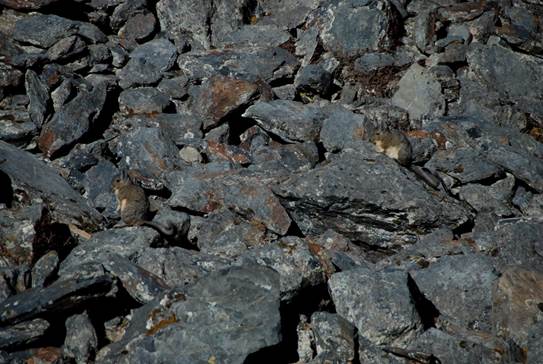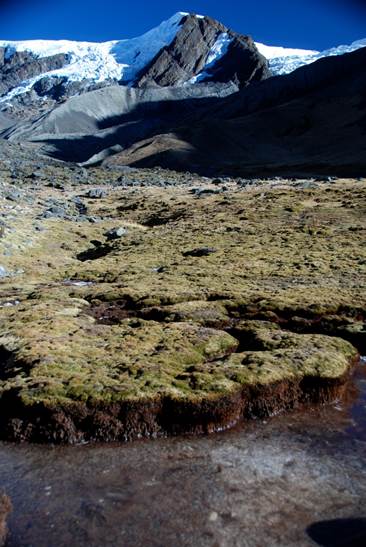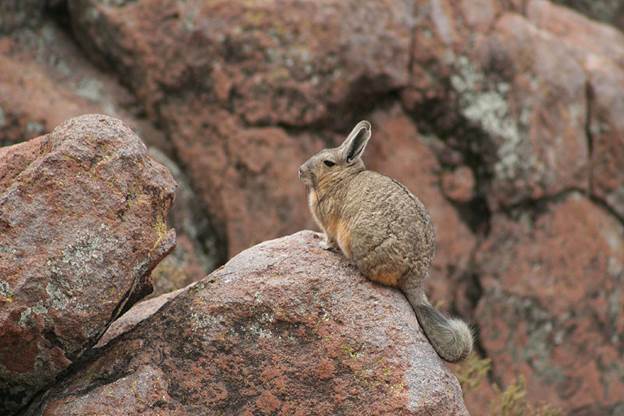Se debe subir tan rapido como un viscacha (You must climb as fast as a viscacha) –Pedro’s urging at 15,000 ft in the Quimsa Cruz range.
Viscachas are large South American rodents that have short forelimbs, , long hind limbs, and a long, bushy tail. Their long hair is soft and dense and they have fleshy pads on the soles of their feet that assist their scampering around the talus. There are four species of viscacha. The three species of mountain viscacha (genus Lagidiuim) are found in the Andes Mountains from central Peru south to Chile and Argentina at altitudes between 13,000 and 16,000 ft. Plains viscacha (Lagostomus) live in the grasslands of Argentina, Paraguay, and southeastern Bolivia.
All viscacha are in the family Chinchillidae – which includes the familiar chinchilla, though the mountain viscachas are related more closely to chinchillas then they are to the grassland viscacha. Lagidium – from the Latin lagos, meaning hare-like.
The Southern viscacha is found in Argentina, Chile, Bolivia, and Peru. Because of their long ears, large hind feet, and a habit of sitting up on their hind legs they look like some odd cross between a rabbit and a small marmot. They are colonial, living in large groups in the mountains among the rocks. They weigh about 6.5 lbs and are crepuscular – most active during the dawn and dusk, foraging and then returning to their burrows within the rock crevices or just lay around on rocks. They eat a variety of grasses, forbs, mosses, and lichen in the relatively sparsely vegetated high mountains.
They will spend part of the day lounging on a rock in the sun, grooming, or just generally resting, but always within easy escape to beneath large rocks. They are preyed upon regularly by the Andean mountain cat, a moderate sized-predator. The color of their fur varies seasonally and with age but in general the upper parts are gray to brown with tints of cream and black while the under-parts are pale yellow or tan. Viscacha hair is sometimes used in the intricate weavings of the local Aymara and Quecha people of the altiplano and their image also shows up regularly in repeated weaving motifs.
Breeding is thought to occur in the last quarter of the year with an estimated gestation period of 120 – 140 days. One precocial pup is born with open eyes and is fully haired – twins are very rare. They wean from their mothers in eight weeks and are fully mature when they are one year old. Their lifespan in the wild is unknown but a captive individual lived 19 years.

Even after spending a month between 12,000 and 20,000 ft with my climbing partner Pedro, I was a bit weary and climbing a bit slow on a rock tower in the Quimsa Cruz range of Bolivia – Pedro referred to the speed of the viscachas nearby while encouraging me. While I appreciated the encouragement, my hemoglobin was not cooperating.
I continued on and we eventually tagged the summit, spilt the cheese and apple we brought along, then rappelled back towards camp where I took a nap in the late afternoon sun. When I awoke the vascachas had come out to forage and were busily munching on grass and hopping around while the shadows grew long. There must have been 30 or more of them in sight, scampering about the rocks and occasionally standing on their hind legs for a better view. They were struck me as an odd lot and you knew you were a long way from the mountains of the PNW.

